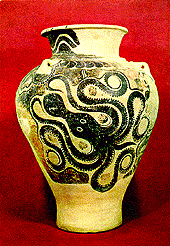
Gas Hydrate Modeling in the Lower Paleozoic and the onset and termination of glacial events
P. Wilde
Pangloss Foundation
Berkeley, California, 94709, USA
M. S. Quinby-Hunt
Environmental Energy Technologies Division
Lawrence Berkeley Laboratory
Berkeley, California, 94720, USA
Presented at the 8th Goldschmidt Conference; Toulouse, France; 30 August-3 September 1998
Mineralogical Magazine, v. 62A, p. 1658-1659.
Expanded ABSTRACT
Dickens and Quinby-Hunt (1994) investigated the stability of methane hydrates in sea water as a function of temperature and pressure (depth). Quinby-Hunt and Wilde (1995) proposed that methane hydrates act as a major climate modulator in the Lower Paleozoic and developed a qualitative model to describe the processes leading to glaciation inter-glaciation (warming) and return to glaciation. Plotting hypothetical oceanic temperature profiles for various climatic conditions (glacial, inter-glacial, and non glacial: Wilde, 1987) on the hydrate-seawater stability diagram (Fig. 1) provides a method to predict quantitative indication of the potential uptake and release of methane to and from the environment with climate change. Using the above, in conjunction with geologic inventories from Budyko (1985) for the Lower Paleozoic, we postulate a geochemical scenario for the Late Ordovician glacial events (Wilde et al., 1996).
Prior to the Devonian, oceanic productivity is the only major biologic process which would sequester carbon. Therefore the pre-Devonian provides a simpler case for examination of glaciation processes. During the Lower Paleozoic extensive areas of oceanic anoxia existed; oxygen concentrations in the atmosphere and upper ocean were significantly lower than in the present. Therefore conditions were auspicious for the formation of methane, and subsequently methane hydrates.
Paleogeographic reconstructions show increased oceanic areas in regions of high organic productivity in the Late Ordovician. Our model suggest that increased sequestration of carbon dioxide (by either biological or geological means) produces initial glaciation, and consequentially ocean cooling. Oceanic cooling increases the area of the sea floor susceptible to methane hydrate formation. Concurrent with increased sequestration is increased productivity, enhanced in the Lower Paleozoic by high levels of atmospheric carbon dioxide. Methane is produced by decomposition of unoxidized organic matter reaching the sea floor. Methane so generated is incorporated into hydrates.
With glaciation, ocean volumes are reduced. Reduced oceanic volumes hasten the trend toward methane saturation. Eventually saturation is reached and methane is expressed into the atmosphere, which induces a warming trend temporarily over-riding the effect of carbon sequestering. Warming causes rising sea levels, increased oceanic volumes, and enhanced productivity on the shelf. As this occurs, methane is again stored as hydrates and the cooling resumes defining an interglacial interval. Glacial-Interglacial cycles would continue as long as the overall oceanic productivity is high. The glacial event terminated, presumably in the Late Ordovician Ashgill, by cessation of high productivity possibly by reduction of the oceanic area located in high productivity zones by the drift of continental blocks into regions of high productivity.
This scenario provides (1) a causal mechanism for both warming and cooling; (2) a feedback mechanism for producing glacial-interglacial intervals; and (3) a procedure for ultimate termination of the glacial event and a return to generally warm global conditions.
Use of the hydrate stability curves in conjunction with oxygen solubility curves provides a mechanism for quantifying the extent of hydrate formation throughout the glaciation cycle.
References
Budyko, O. M. I., Ronov, A. B. and Yanshin, A. L. (1985) History of the Earth's Atmosphere Springer-Verlag Berlin , 139p.
Dickens, G. R. and Quinby-Hunt, M. S. (1994) Geophys. Res. Ltrs., 21, 2115-8.
Quinby-Hunt, M.S. and P. Wilde. (1995) EOS, 76 no. 46, p. F306
Wilde, P. (1987) Am. Jour. Sci., 287, 442-59
Wilde, P., Quinby-Hunt, M. S. and Erdtmann, B.-D. (1996) Sed. Geol., 101, 45-53.